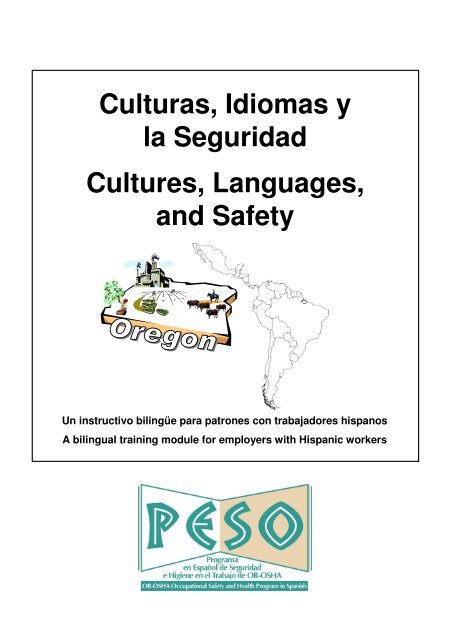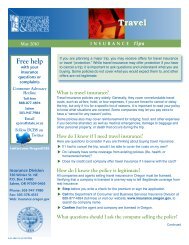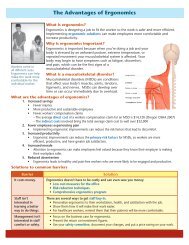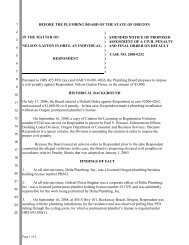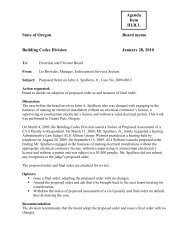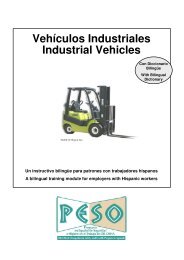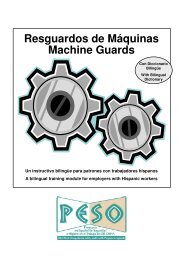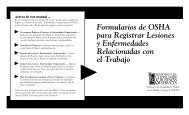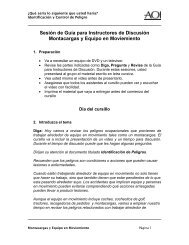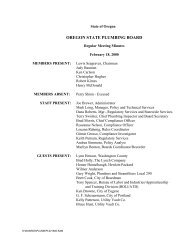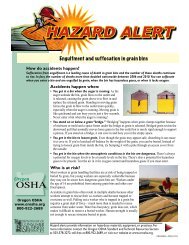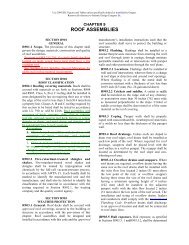Culturas, Idiomas y la Seguridad Cultures, Languages, and Safety
Culturas, Idiomas y la Seguridad Cultures, Languages, and Safety
Culturas, Idiomas y la Seguridad Cultures, Languages, and Safety
You also want an ePaper? Increase the reach of your titles
YUMPU automatically turns print PDFs into web optimized ePapers that Google loves.
<strong>Culturas</strong>, <strong>Idiomas</strong> y<br />
<strong>la</strong> <strong>Seguridad</strong><br />
<strong>Cultures</strong>, <strong>Languages</strong>,<br />
<strong>and</strong> <strong>Safety</strong><br />
Un instructivo bilingüe para patrones con trabajadores hispanos<br />
A bilingual training module for employers with Hispanic workers
TO USE THIS TRAINING MODULE:<br />
This OR-OSHA training module is designed so that both English <strong>and</strong> Spanish-speaking<br />
people can use it. The left-sided pages are in English <strong>and</strong> the right-sided pages are in<br />
Spanish.<br />
STEP 1<br />
STEP 2<br />
STEP 3<br />
STEP 4<br />
Print all the module pages.<br />
Photocopy the entire module copying<br />
on both sides of each page. The even<br />
pages (2, 4, 6, etc.) must be in English.<br />
The odd pages (3, 5, 7, etc.) must be in<br />
Spanish.<br />
Staple or bind each module. Make<br />
sure that the pages in English are<br />
on the left <strong>and</strong> the pages in Spanish<br />
are on the right.<br />
Provide the training. It is suggested<br />
that before giving the training, you<br />
read the OR-OSHA module <strong>Cultures</strong>,<br />
<strong>Languages</strong>, <strong>and</strong> <strong>Safety</strong>, avai<strong>la</strong>ble<br />
from the OR-OSHA web site.<br />
Toll free number in Spanish: 1 (800) 843-8086 option No. 3<br />
Toll free number in English: 1 (800) 922-2689<br />
Web site: www.orosha.org<br />
Instrucciones en español:<br />
pasta interior de atrás<br />
English Spanish
Programa en Español de <strong>Seguridad</strong> e Higiene en el<br />
Trabajo de OR-OSHA<br />
OR-OSHA Occupational <strong>Safety</strong> <strong>and</strong> Health<br />
Program in Spanish<br />
These modules are<br />
designed to be taught in<br />
30 to 60 minutes.<br />
Obtain these bilingual training<br />
modules <strong>and</strong> the<br />
Spanish-English / English-Spanish<br />
Occupational <strong>Safety</strong> <strong>and</strong> Health<br />
Dictionary (30,000 words) at<br />
www.orosha.org<br />
Please send comments to tomas.schwabe@state.or.us Favor de enviar comentarios a tomas.schwabe@state.or.us<br />
Nota: Este material educativo o cualquier otro material utilizado para adiestrar a patrones y empleados de los requisitos de<br />
cumplimiento de los reg<strong>la</strong>mentos de <strong>la</strong> OR-OSHA por conducto de <strong>la</strong> simplificación de los reg<strong>la</strong>mentos, no se considerará<br />
substituto de cualquiera de <strong>la</strong>s previsiones de <strong>la</strong> Ley de <strong>Seguridad</strong> en el Trabajo de Oregon, o por cualquiera de <strong>la</strong>s normas<br />
dictaminadas por <strong>la</strong> OR-OSHA. Este material educativo fue producido por el Programa PESO de <strong>la</strong> OR-OSHA.<br />
Note: This educational material or any other material used to inform employers <strong>and</strong> workers of compliance requirements of<br />
OR-OSHA st<strong>and</strong>ards through simplification of the regu<strong>la</strong>tions should not be considered a substitute for any provisions of the<br />
Oregon Safe Employment Act or for any st<strong>and</strong>ards issued by OR-OSHA. This educational material was produced by the<br />
OR-OSHA PESO Program.<br />
For training purposes only<br />
OR-OSHA PESO - CULTURES, LANGUAGES, AND SAFETY<br />
3<br />
Estos instructivos están<br />
diseñados para ser<br />
enseñados en 30 a 60<br />
minutos.<br />
Obtenga estos instructivos<br />
bilingües y el<br />
Diccionario Español-Inglés / Inglés-<br />
Español de <strong>Seguridad</strong> e Higiene en<br />
el Trabajo (30,000 pa<strong>la</strong>bras) en<br />
www.orosha.org<br />
Unicamente para adiestramiento<br />
OR-OSHA PESO - CULTURAS, IDIOMAS , Y LA SEGURIDAD
Welcome!<br />
The reason for this course<br />
Oregon employers who are hiring a growing<br />
number of Hispanic workers are dem<strong>and</strong>ing<br />
bilingual job safety <strong>and</strong> health training<br />
materials.<br />
The goal of this course<br />
Provide Oregon employers with tools to<br />
provide effective occupational safety <strong>and</strong><br />
health training to Hispanic workers.<br />
For training purposes only<br />
OR-OSHA PESO - CULTURES, LANGUAGES, AND SAFETY<br />
Job Applications<br />
Solicitudes de<br />
Empleo<br />
4<br />
Unicamente para adiestramiento<br />
OR-OSHA PESO - CULTURAS, IDIOMAS , Y LA SEGURIDAD
¡Bienvenidos!<br />
La razón de este curso<br />
Patrones de Oregon que están contrat<strong>and</strong>o a<br />
un número creciente de trabajadores Hispanos<br />
están dem<strong>and</strong><strong>and</strong>o materia de enseñamiento<br />
bilingüe en seguridad e higiene en el trabajo.<br />
La meta de este curso<br />
Proporcionar a patrones de Oregon con<br />
herramientas para proveer adiestramiento<br />
efectivo en <strong>la</strong> seguridad e higiene en el trabajo<br />
a empleados Hispanos.<br />
For training purposes only<br />
OR-OSHA PESO - CULTURES, LANGUAGES, AND SAFETY<br />
Solicitudes de<br />
Empleo<br />
Job Applications<br />
5<br />
Unicamente para adiestramiento<br />
OR-OSHA PESO - CULTURAS, IDIOMAS , Y LA SEGURIDAD
Today´s training . . .<br />
Job training for limited-English Hispanic workers in many Oregon workp<strong>la</strong>ces<br />
often happens like this:<br />
• The trainer, usually a native English speaker without bilingual skills,<br />
grabs a native Spanish speaker with some English skills from the group<br />
of workers, <strong>and</strong> uses this person as an interpreter.<br />
• The training begins with the trainer speaking through the interpreter.<br />
• Sometime during the training session, the trainer asks the trainees if<br />
there are any questions.<br />
• The trainees hardly ever have any questions.<br />
• The training ends with the trainer asking the trainees if they<br />
understood everything.<br />
• The trainees nod their heads in a “yes” motion, indicating they<br />
understood everything.<br />
For training purposes only<br />
OR-OSHA PESO - CULTURES, LANGUAGES, AND SAFETY<br />
6<br />
They didn’t.<br />
Unicamente para adiestramiento<br />
OR-OSHA PESO - CULTURAS, IDIOMAS , Y LA SEGURIDAD
El entrenamiento de hoy . . .<br />
La capacitación <strong>la</strong>boral para trabajadores que saben poco inglés en muchos<br />
lugares de trabajo a menudo ocurre de <strong>la</strong> siguiente manera.<br />
• El instructor, por lo general una persona cuya lengua materna es el<br />
inglés sin ser bilingüe, toma a una persona cuya lengua materna es el<br />
español con algún poder de hab<strong>la</strong>r el inglés del grupo de trabajadores,<br />
y utiliza a esta persona como interprete.<br />
• Comienza el adiestramiento con el instructor hab<strong>la</strong>ndo a través del<br />
interprete.<br />
• En el transcurso de <strong>la</strong> sesión, el instructor cuestiona a los participantes<br />
si tienen preguntas.<br />
• Los participantes casi nunca tienen preguntas.<br />
• Se termina <strong>la</strong> sesión de adiestramiento con el instructor preguntándole<br />
a los participantes si entendieron todo.<br />
• Los participantes asienten con <strong>la</strong> cabeza que entendieron todo.<br />
For training purposes only<br />
OR-OSHA PESO - CULTURES, LANGUAGES, AND SAFETY<br />
7<br />
No entendieron.<br />
Unicamente para adiestramiento<br />
OR-OSHA PESO - CULTURAS, IDIOMAS , Y LA SEGURIDAD
Effective training<br />
Job safety training between people of<br />
different <strong>la</strong>nguages <strong>and</strong> cultures can be<br />
done effectively. Follow these steps:<br />
1. Form an effective training<br />
team.<br />
2. Communicate the<br />
company’s belief that<br />
worker safety is important.<br />
3. Initiate worker<br />
participation.<br />
4. Conduct safety training.<br />
For training purposes only<br />
OR-OSHA PESO - CULTURES, LANGUAGES, AND SAFETY<br />
8<br />
Unicamente para adiestramiento<br />
OR-OSHA PESO - CULTURAS, IDIOMAS , Y LA SEGURIDAD
Adiestramiento efectivo<br />
La capacitación <strong>la</strong>boral entre personas de<br />
diferentes idiomas y culturas puede lograrse<br />
eficazmente. Siga los siguientes pasos:<br />
1. Forme un equipo de<br />
capacitación eficaz.<br />
2. Comunique <strong>la</strong> convicción de<br />
<strong>la</strong> compañía que <strong>la</strong><br />
seguridad de los<br />
trabajadores es importante.<br />
3. Inicie <strong>la</strong> participación de los<br />
trabajadores.<br />
4. Realice <strong>la</strong> capacitación de<br />
seguridad.<br />
For training purposes only<br />
OR-OSHA PESO - CULTURES, LANGUAGES, AND SAFETY<br />
9<br />
Unicamente para adiestramiento<br />
OR-OSHA PESO - CULTURAS, IDIOMAS , Y LA SEGURIDAD
What is next?<br />
1. Form an effective training<br />
team.<br />
2. Communicate the<br />
company’s belief that<br />
worker safety is important.<br />
3. Initiate worker<br />
participation.<br />
4. Conduct safety training.<br />
For training purposes only<br />
OR-OSHA PESO - CULTURES, LANGUAGES, AND SAFETY<br />
10<br />
Unicamente para adiestramiento<br />
OR-OSHA PESO - CULTURAS, IDIOMAS , Y LA SEGURIDAD
¿Que sigue?<br />
1. Forme un equipo de<br />
capacitación eficaz.<br />
2. Comunique <strong>la</strong> convicción<br />
de <strong>la</strong> compañía que <strong>la</strong><br />
seguridad de los trabajadores<br />
es importante.<br />
Inicie <strong>la</strong> participación de los<br />
trabajadores.<br />
Realice <strong>la</strong> capacitación de<br />
seguridad.<br />
For training purposes only<br />
OR-OSHA PESO - CULTURES, LANGUAGES, AND SAFETY<br />
11<br />
Unicamente para adiestramiento<br />
OR-OSHA PESO - CULTURAS, IDIOMAS , Y LA SEGURIDAD
Form an effective training team<br />
To be effective, newly hired workers must learn many things<br />
quickly. They must learn how to do the job, they must learn how to<br />
act safely, <strong>and</strong> they must learn the workp<strong>la</strong>ce’s unique culture. It is<br />
important for owners who hire Hispanic workers with limited<br />
English skills to know that because of this <strong>la</strong>nguage barrier, these<br />
workers need more help than native English speaking workers in<br />
learning how to do the job, how to act safely, <strong>and</strong> how to be<br />
consistent with the owner’s beliefs <strong>and</strong> values.<br />
Form an effective training team consisting of the following key<br />
people:<br />
Language Leader – The person<br />
with the best bilingual skills.<br />
Social Leader – The person the group<br />
recognizes as their leader.<br />
Technical Leader – The person<br />
with the best skills <strong>and</strong> knowledge to get the job<br />
done.<br />
For training purposes only<br />
OR-OSHA PESO - CULTURES, LANGUAGES, AND SAFETY<br />
12<br />
Unicamente para adiestramiento<br />
OR-OSHA PESO - CULTURAS, IDIOMAS , Y LA SEGURIDAD
Formar un equipo de capacitación eficaz<br />
Pare ser eficaces, los trabajadores recientemente contratados deben<br />
aprender cosas rápidamente. Deben aprender como hacer el trabajo,<br />
como hacerlo de una manera segura, y deben aprender <strong>la</strong> cultura<br />
particu<strong>la</strong>r del lugar de trabajo. Es importante que los dueños que<br />
contratan a trabajadores hispanos que saben poco inglés, sepan que estos<br />
trabajadores necesitan más ayuda que los trabajadores cuya lengua<br />
materna es el inglés en aprender como hacer el trabajo, como actuar de<br />
manera segura, y como acoplárse a <strong>la</strong>s convicciones y valores del dueño.<br />
Forme un equipo de capacitación eficaz formado por <strong>la</strong>s siguientes<br />
personas c<strong>la</strong>ves:<br />
Líder de Idioma – La persona con <strong>la</strong><br />
mejor habilidad bilingüe.<br />
Líder Social – La persona que el grupo<br />
reconoce como su líder.<br />
Líder Técnico – La persona con <strong>la</strong> mejor<br />
habilidad y conocimientos para hacer el trabajo.<br />
For training purposes only<br />
OR-OSHA PESO - CULTURES, LANGUAGES, AND SAFETY<br />
13<br />
Unicamente para adiestramiento<br />
OR-OSHA PESO - CULTURAS, IDIOMAS , Y LA SEGURIDAD
Form an effective training team<br />
Social<br />
Leader<br />
For training purposes only<br />
OR-OSHA PESO - CULTURES, LANGUAGES, AND SAFETY<br />
Language<br />
Leader<br />
Workers<br />
14<br />
Technical<br />
Leader<br />
Unicamente para adiestramiento<br />
OR-OSHA PESO - CULTURAS, IDIOMAS , Y LA SEGURIDAD
Formar un equipo de capacitación eficaz<br />
Líder<br />
Social<br />
For training purposes only<br />
OR-OSHA PESO - CULTURES, LANGUAGES, AND SAFETY<br />
Líder de<br />
Idioma<br />
Trabajadores<br />
15<br />
Líder<br />
Técnico<br />
Unicamente para adiestramiento<br />
OR-OSHA PESO - CULTURAS, IDIOMAS , Y LA SEGURIDAD
Form an effective training team<br />
The Language Leader can be a worker, a foreman, a supervisor or a<br />
professional interpreter. If the job is complex <strong>and</strong> requires multiple safety<br />
measures, it may be very important to obtain the services of a professional<br />
interpreter.<br />
Without the Language Leader as a member of the training team,<br />
communication will likely be limited to h<strong>and</strong> signs.<br />
If you are p<strong>la</strong>nning on using one of the workers as the interpreter, identifying<br />
the Language Leader is easy. Simply ask the group of workers, “who speaks<br />
the best English?” “¿quien hab<strong>la</strong> el mejor inglés?” [Key-en Ab<strong>la</strong>h L Mayhor<br />
Een-g<strong>la</strong>ze?]<br />
In most cases, someone in the group will volunteer to speak English.<br />
Congratu<strong>la</strong>tions, you have identified the Language Leader of the group!<br />
For training purposes only<br />
OR-OSHA PESO - CULTURES, LANGUAGES, AND SAFETY<br />
16<br />
Language<br />
Leader<br />
Unicamente para adiestramiento<br />
OR-OSHA PESO - CULTURAS, IDIOMAS , Y LA SEGURIDAD
Formar un equipo de capacitación eficaz<br />
El Líder de Idioma puede ser un trabajador, un mayordomo, un supervisor,<br />
o un interprete profesional. Si el trabajo es complicado y requiere múltiples<br />
medidas de seguridad, puede ser muy importante el obtener los servicios de un<br />
interprete profesional.<br />
Sin el Líder de Idioma como miembro del equipo de capacitación, <strong>la</strong><br />
comunicación probablemente estará limitada a señales de mano.<br />
Si piensa usar uno de los trabajadores como intérprete, el identificar el Lider de<br />
Idioma es fácil. Simplemente pregúntele al grupo, -¿quien hab<strong>la</strong> el mejor inglés?<br />
En <strong>la</strong> mayoría de los casos, alguién del grupo se nombrará para hab<strong>la</strong>r inglés.<br />
¡Felicidades, ha identificado al Líder de Idioma del grupo!<br />
For training purposes only<br />
OR-OSHA PESO - CULTURES, LANGUAGES, AND SAFETY<br />
17<br />
Líder de<br />
Idioma<br />
Unicamente para adiestramiento<br />
OR-OSHA PESO - CULTURAS, IDIOMAS , Y LA SEGURIDAD
Form an effective training team<br />
The Social Leader is usually one of the workers. This person may be the<br />
individual who helped the workers get to Oregon from Latin America,<br />
someone in high st<strong>and</strong>ing in the group’s home vil<strong>la</strong>ge, or simply, the person<br />
recognized as the one who makes the important group decisions or who<br />
influences others.<br />
Without the Social Leader as a member of the training team, the group may<br />
not trust what is being communicated. If the Social Leader is excluded from<br />
the training team <strong>and</strong> he or she <strong>and</strong> the Language Leader don’t trust each<br />
other, the training session could be undermined by the Social Leader with<br />
just a few g<strong>la</strong>nces to coworkers.<br />
Identifying the Social Leader is also easy. If the group has been together for<br />
a period of time, the Social Leader is probably already known to you. If not,<br />
ask the group, “who is your Leader?” “¿quien es el lider de ustedes?” [Keyen<br />
Ays L Lee-dare Day oos-tay-days?]<br />
In most cases, someone in the group will identify who is the leader.<br />
Congratu<strong>la</strong>tions, you have identified the Social Leader of the group!<br />
For training purposes only<br />
OR-OSHA PESO - CULTURES, LANGUAGES, AND SAFETY<br />
18<br />
Social<br />
Leader<br />
Unicamente para adiestramiento<br />
OR-OSHA PESO - CULTURAS, IDIOMAS , Y LA SEGURIDAD
Formar un equipo de capacitación eficaz<br />
El Líder Social por lo general, es uno de los trabajadores. Esta persona puede<br />
se el individuo que ayudó a los trabajadores a llegar a Oregon de Latino América,<br />
alguien importante del pueblo natal del grupo, o sencil<strong>la</strong>mente, una persona<br />
reconocida como <strong>la</strong> persona que hace <strong>la</strong>s decisiones importantes o influye a otros.<br />
Sin el Líder Social como miembro del equipo de capacitación, puede que el grupo<br />
no confíe en lo que se esta diciendo. Si al Líder Social se le excluye del equipo de<br />
capacitación y él y el Líder de Idioma no se tienen confianza, <strong>la</strong> sesión de<br />
capacitación podría ser minado por el Líder Social con unas cuantas miradas a<br />
los compañeros de trabajo.<br />
La identificación del Líder Social también es fácil. Si el grupo ha estado formado<br />
un buen tiempo, es probable que usted ya conoce el Líder Social. Si no,<br />
pregúntele al grupo, -¿quien es el lider de ustedes?-<br />
En <strong>la</strong> mayoría de los casos, alguien del grupo nombrará quien es el líder.<br />
¡Felicidades, ha identificado al Líder de Idioma del grupo!<br />
For training purposes only<br />
OR-OSHA PESO - CULTURES, LANGUAGES, AND SAFETY<br />
19<br />
Líder<br />
Social<br />
Unicamente para adiestramiento<br />
OR-OSHA PESO - CULTURAS, IDIOMAS , Y LA SEGURIDAD
Form an effective training team<br />
The Technical Leader can be the owner, the foreman, the supervisor, or the<br />
person with the most experience. The Technical Leader must have two<br />
important qualities: He or she must know how to do the job well <strong>and</strong> be able to<br />
do it safely – high production but without safety shortcuts!<br />
Without the Technical Leader as a member of the training team the best <strong>and</strong><br />
safest way to do the job will not be communicated. It is harder to relearn to do<br />
something right than to be taught to do it right the first time.<br />
Identifying the Technical Leader is also easy. Who is the person that can do the<br />
job the best, the most efficiently <strong>and</strong> most safely?<br />
When you answer the question above, you will know who is the Technical<br />
Leader.<br />
Congratu<strong>la</strong>tions, you have identified the three key people in your training team!<br />
For training purposes only<br />
OR-OSHA PESO - CULTURES, LANGUAGES, AND SAFETY<br />
20<br />
Technical<br />
Leader<br />
Unicamente para adiestramiento<br />
OR-OSHA PESO - CULTURAS, IDIOMAS , Y LA SEGURIDAD
Formar un equipo de capacitación eficaz<br />
El Líder Técnico puede ser el dueño, el mayordomo, el supervisor, o <strong>la</strong><br />
persona con más experiencia. El Líder Técnico debe tener dos cualidades<br />
importantes: Debe saber como hacer el trabajo bien y poder hacerlo de manera<br />
segura – ¡alta producción pero sin atajos de seguridad!<br />
Sin el Líder Técnico como miembro del equipo de capacitación <strong>la</strong> mejor y más<br />
segura manera de hacer el trabajo no se comunicará. Es más difícil volver a<br />
aprender a hacer algo de <strong>la</strong> manera correcta que ser enseñado a hacerlo bien <strong>la</strong><br />
primera vez.<br />
La identficación del Líder Técnico también es fácil. ¿Quien es <strong>la</strong> persona que<br />
puede hacer el trabajo mejor, con más eficiencia y de <strong>la</strong> manera más segura?<br />
Cu<strong>and</strong>o conteste <strong>la</strong> pregunta anterior, sabrá quien es el Líder Técnico.<br />
¡Felicidades, ha identificado a <strong>la</strong>s tres personas c<strong>la</strong>ves de su equipo de<br />
capacitación!<br />
For training purposes only<br />
OR-OSHA PESO - CULTURES, LANGUAGES, AND SAFETY<br />
21<br />
Líder<br />
Técnico<br />
Unicamente para adiestramiento<br />
OR-OSHA PESO - CULTURAS, IDIOMAS , Y LA SEGURIDAD
What is next?<br />
1. Form an effective training<br />
team.<br />
2. Communicate the<br />
company’s belief that<br />
worker safety is important.<br />
3. Initiate worker<br />
participation.<br />
4. Conduct safety training.<br />
For training purposes only<br />
OR-OSHA PESO - CULTURES, LANGUAGES, AND SAFETY<br />
22<br />
Unicamente para adiestramiento<br />
OR-OSHA PESO - CULTURAS, IDIOMAS , Y LA SEGURIDAD
¿Que sigue?<br />
1. Forme un equipo de<br />
capacitación eficaz.<br />
2. Comunique <strong>la</strong> convicción<br />
de <strong>la</strong> compañía que <strong>la</strong><br />
seguridad de los trabajadores<br />
es importante.<br />
Inicie <strong>la</strong> participación de los<br />
trabajadores.<br />
Realice <strong>la</strong> capacitación de<br />
seguridad.<br />
For training purposes only<br />
OR-OSHA PESO - CULTURES, LANGUAGES, AND SAFETY<br />
23<br />
Unicamente para adiestramiento<br />
OR-OSHA PESO - CULTURAS, IDIOMAS , Y LA SEGURIDAD
Communicate the company´s belief in the<br />
importance of worker safety<br />
The company’s owner must recognize that worker safety is as important as<br />
production, <strong>and</strong> effectively communicate this belief. This is accomplished<br />
through establishing an effective accountability system. Managers, supervisors<br />
<strong>and</strong> foremen actions must be measured by meeting both safety <strong>and</strong> production<br />
goals.<br />
<strong>Safety</strong> Leadership!<br />
When someone doesn’t speak the <strong>la</strong>nguage, much of the learning takes p<strong>la</strong>ce<br />
visually. For this reason, a company hiring limited-English speaking workers<br />
must ensure that safe work procedures are already in p<strong>la</strong>ce.<br />
For training purposes only<br />
OR-OSHA PESO - CULTURES, LANGUAGES, AND SAFETY<br />
Here’s an example of a dangerous<br />
non-verbal training session: A newly<br />
hired Spanish-speaking worker sees a<br />
coworker walk through the<br />
construction site without wearing his<br />
hardhat. The coworker stops to chat<br />
to a foreman who also is not wearing<br />
his hardhat.<br />
The message: You don´t have to wear<br />
a hardhat on this job site!<br />
24<br />
Unicamente para adiestramiento<br />
OR-OSHA PESO - CULTURAS, IDIOMAS , Y LA SEGURIDAD
Comunicar <strong>la</strong> convicción de <strong>la</strong> compañía que <strong>la</strong><br />
seguridad del los trabajadores es importante<br />
El dueño de <strong>la</strong> compañía debe reconocer que <strong>la</strong> seguridad de los trabajadores es<br />
tan importante como <strong>la</strong> producción, y de un manera eficaz, comunicar esta<br />
convicción. Esto se logra a través de formar un sistema efectivo de<br />
responsabilidad. Las acciones de los gerentes, supervisores y mayordomos se<br />
deben medir al cumplir tanto <strong>la</strong>s metas de seguridad como <strong>la</strong>s de producción.<br />
¡Liderazgo en <strong>Seguridad</strong>!<br />
Cu<strong>and</strong>o alguien no hab<strong>la</strong> el idioma, <strong>la</strong> mayoría del aprendizaje ocurre con <strong>la</strong><br />
vista. Por esto, un compañía que contrata trabajadores con poca facilidad del<br />
inglés debe cerciorarse que <strong>la</strong>s prácticas y los procedimientos de seguridad ya<br />
estén en pié.<br />
For training purposes only<br />
OR-OSHA PESO - CULTURES, LANGUAGES, AND SAFETY<br />
He aquí un ejemplo de una sesión de<br />
capacitación sin pa<strong>la</strong>bras peligroso:<br />
Un trabajador recientemente<br />
contratado de hab<strong>la</strong> español, ve un<br />
compañero de trabajo camin<strong>and</strong>o por<br />
<strong>la</strong> obra sin usar su casco. El<br />
compañero de trabajo se detiene a<br />
char<strong>la</strong>r con un mayordomo y quien<br />
tampoco esta us<strong>and</strong>o su casco.<br />
¡El mensaje: No tiene que ponerse un<br />
casco en esta obra!<br />
25<br />
Unicamente para adiestramiento<br />
OR-OSHA PESO - CULTURAS, IDIOMAS , Y LA SEGURIDAD
What is next?<br />
1. Form an effective training<br />
team.<br />
2. Communicate the<br />
company’s belief that<br />
worker safety is important.<br />
3. Initiate worker<br />
participation.<br />
4. Conduct safety training.<br />
For training purposes only<br />
OR-OSHA PESO - CULTURES, LANGUAGES, AND SAFETY<br />
26<br />
Unicamente para adiestramiento<br />
OR-OSHA PESO - CULTURAS, IDIOMAS , Y LA SEGURIDAD
¿Que sigue?<br />
1. Forme un equipo de<br />
capacitación eficaz.<br />
2. Comunique <strong>la</strong> convicción<br />
de <strong>la</strong> compañía que <strong>la</strong><br />
seguridad de los trabajadores<br />
es importante.<br />
Inicie <strong>la</strong> participación de los<br />
trabajadores.<br />
Realice <strong>la</strong> capacitación de<br />
seguridad.<br />
For training purposes only<br />
OR-OSHA PESO - CULTURES, LANGUAGES, AND SAFETY<br />
27<br />
Unicamente para adiestramiento<br />
OR-OSHA PESO - CULTURAS, IDIOMAS , Y LA SEGURIDAD
Initate worker participation<br />
3 ideas to encourage worker<br />
participation:<br />
Have a Conversation About Cultural<br />
Attitudes Toward <strong>Safety</strong>.<br />
<strong>Safety</strong> Award Program.<br />
Hazard Identification Contest.<br />
For training purposes only<br />
OR-OSHA PESO - CULTURES, LANGUAGES, AND SAFETY<br />
28<br />
Unicamente para adiestramiento<br />
OR-OSHA PESO - CULTURAS, IDIOMAS , Y LA SEGURIDAD
Iniciar <strong>la</strong> participación de los trabajadores<br />
3 ideas para promover <strong>la</strong> participación<br />
de los trabajadores:<br />
Sostener una Plática de <strong>la</strong>s Actitudes<br />
Culturales Sobre <strong>la</strong> <strong>Seguridad</strong>.<br />
Programa de Premio de <strong>Seguridad</strong>.<br />
Concurso de Identificación de<br />
Riesgos.<br />
For training purposes only<br />
OR-OSHA PESO - CULTURES, LANGUAGES, AND SAFETY<br />
29<br />
Unicamente para adiestramiento<br />
OR-OSHA PESO - CULTURAS, IDIOMAS , Y LA SEGURIDAD
Initate worker participation<br />
Have a Conversation About Cultural Attitudes Toward <strong>Safety</strong><br />
Asking someone’s opinion makes them feel valued. Here are safety questions to ask<br />
that will make the workers the experts <strong>and</strong> will teach you about them!<br />
What rights do workers have in your country regarding a safe work<br />
environment?<br />
During the time you have been working in the United States, do you pay<br />
a) more attention b) less attention c) same attention<br />
to safety than you had to pay in your country?<br />
Which safety rules here are different from those in your country? What<br />
safety rules are the same?<br />
Are there safety committees in your country? If so, how often do they meet?<br />
In the companies you worked for in your country, were safety inspections<br />
conducted?<br />
From your work experience, what happened in case of a serious injury in<br />
your country?<br />
Did you use personal protective equipment in your country? Was it<br />
voluntary or m<strong>and</strong>atory?<br />
What are some of the reasons that people don’t follow workp<strong>la</strong>ce safety rules<br />
even though they know them? (U.S. or in your country)<br />
For training purposes only<br />
OR-OSHA PESO - CULTURES, LANGUAGES, AND SAFETY<br />
30<br />
Unicamente para adiestramiento<br />
OR-OSHA PESO - CULTURAS, IDIOMAS , Y LA SEGURIDAD
Iniciar <strong>la</strong> participación de los trabajadores<br />
Sostener una Plática de <strong>la</strong>s Actitudes Culturales Sobre <strong>la</strong> <strong>Seguridad</strong><br />
El preguntarle a alguien su opinión, lo hace sentirse valorado. Aquí hay preguntas<br />
sobre <strong>la</strong> seguridad que harán de los trabajadores los expertos, y, ¡le enseñará algo de<br />
ellos!<br />
¿Cuáles derechos tienen los trabajadores en su país en cuanto a un ambiente<br />
de trabajo seguro?<br />
Durante el tiempo en que ha estado trabaj<strong>and</strong>o en los Estados Unidos, ¿cree<br />
usted que ha tenido que prestar<br />
a) más atención b) menos atención c) <strong>la</strong> misma atención<br />
a <strong>la</strong> seguridad que tenía que prestar en su país?<br />
¿Cuáles reg<strong>la</strong>s de seguridad son diferentes aquí que <strong>la</strong>s de su país? ¿Cuáles<br />
reg<strong>la</strong>s de seguridad son iguales?<br />
¿Hay comités de seguridad en su país? ¿Si los hay, con qué frecuencia se<br />
reúnen?<br />
¿En <strong>la</strong>s compañías donde trabajaba usted en su país, se llevaban a cabo<br />
inspecciones de seguridad?<br />
¿Qué pasaba en caso de una herida grave en el trabajo en su país, de acuerdo<br />
a su experiencia <strong>la</strong>boral?<br />
¿Utilizaba equipo protector personal en su país? ¿Era voluntario u<br />
obligatorio?<br />
¿Cuáles son algunas de <strong>la</strong>s razones que algunas personas no cumplen con <strong>la</strong>s<br />
reg<strong>la</strong>s de seguridad <strong>la</strong>boral aunque <strong>la</strong>s conozcan? (EE.UU. o en su país)<br />
For training purposes only<br />
OR-OSHA PESO - CULTURES, LANGUAGES, AND SAFETY<br />
31<br />
Unicamente para adiestramiento<br />
OR-OSHA PESO - CULTURAS, IDIOMAS , Y LA SEGURIDAD
Initate worker participation<br />
<strong>Safety</strong> Award Program<br />
Award equipment: A supply of gear, tools, implements, <strong>and</strong> garments, etc. The<br />
items don’t need to be expensive but should be of value <strong>and</strong> usefulness. Here are<br />
some examples:<br />
baseball hat calcu<strong>la</strong>tor<br />
combination lock compass<br />
f<strong>la</strong>shlight miniature screwdrivers set<br />
pocket level tape measure<br />
tool carrier T-shirt<br />
When an employee is observed assisting a coworker to do the safe thing, that<br />
workers’ name is put on the <strong>Safety</strong> Award List to receive a <strong>Safety</strong> Award at the<br />
next employee meeting.<br />
For training purposes only<br />
OR-OSHA PESO - CULTURES, LANGUAGES, AND SAFETY<br />
32<br />
Unicamente para adiestramiento<br />
OR-OSHA PESO - CULTURAS, IDIOMAS , Y LA SEGURIDAD
Iniciar <strong>la</strong> participación de los trabajadores<br />
Programa de Premio de <strong>Seguridad</strong><br />
Herramienta para el premio: Una cantidad de equipo, herramienta,<br />
implementos, ropajes, etc. Estos objetos no necesitan ser caros pero deberían<br />
tener valor y utilidad. He aquí unos ejemplos:<br />
cachucha de béisbol calcu<strong>la</strong>dora<br />
c<strong>and</strong>ado de combinación compás<br />
linterna de baterías equipo de desarmadores miniatura<br />
nivel de bolsillo metro<br />
porta herramientas camiseta<br />
Cu<strong>and</strong>o a un trabajador se le observa ayud<strong>and</strong>o a un compañero de trabajo<br />
hacer algo en una manera segura, el nombre de ese trabajador se le pone en <strong>la</strong><br />
Lista del Programa de Premio de <strong>Seguridad</strong> para recibir un Premio de<br />
<strong>Seguridad</strong> en <strong>la</strong> próxima reunión de trabajadores.<br />
For training purposes only<br />
OR-OSHA PESO - CULTURES, LANGUAGES, AND SAFETY<br />
33<br />
Unicamente para adiestramiento<br />
OR-OSHA PESO - CULTURAS, IDIOMAS , Y LA SEGURIDAD
Initate worker participation<br />
Hazard Identification Contest<br />
Contest Equipment: Three gift certificates to stores in the community that carry<br />
a variety of desirable or needed goods. Examples: sports stores, music <strong>and</strong> video<br />
stores, travel agencies, auto parts stores, electronics stores, restaurants, etc.<br />
It is suggested that the Hazard Identification Contest have a higher award value<br />
than the <strong>Safety</strong> Award Program. For example, if the gift certificates have values<br />
of $100 for First Prize $50 for Second <strong>and</strong> $25 for Third, the total is only $175<br />
per quarter or $700 per year. . . a small investment with a big safety payoff!<br />
A supply of Hazard Identification Sheets (shown below) that identify the hazard<br />
<strong>and</strong> the suggestion for correcting the hazard.<br />
For training purposes only<br />
OR-OSHA PESO - CULTURES, LANGUAGES, AND SAFETY<br />
HAZARD IDENTIFICATION<br />
34<br />
Date _______<br />
Worker ___________________________________<br />
Supervisor ________________________________<br />
Hazard ___________________________________<br />
Hazard location ____________________________<br />
How to fix hazard ____________________________<br />
____________________________________________<br />
____________________________________________<br />
____________________________________________<br />
Continues<br />
Unicamente para adiestramiento<br />
OR-OSHA PESO - CULTURAS, IDIOMAS , Y LA SEGURIDAD
Iniciar <strong>la</strong> participación de los trabajadores<br />
Concurso de Identificación de Riesgos<br />
Herramienta Para el Concurso: Tres certificados de regalo de tiendas en <strong>la</strong><br />
comunidad que surten un variedad de bienes de gusto o necesidad. Ejemplos:<br />
tiendas de deportes, tiendas de musica y video, agencias de viaje, refacciones de<br />
autos, tiendas de equipo electrónico, restaurantes, etc.<br />
Se sugiere que el Concurso de Identificación de Riesgos tenga un valor mayor al<br />
del Programa de Premio de <strong>Seguridad</strong>. Por ejemplo, si los certificados de<br />
premio tienen un valor de $100 para el Primer Lugar, $50 para el Segundo<br />
Lugar, y $25 para el Tercer Lugar, el total es únicamente $175 trimestralmente o<br />
$700 anualmente . . . ¡una pequeña inversión con una gran ganancia en<br />
seguridad!<br />
Una cantidad de hojas titu<strong>la</strong>das Identificación de Riesgos (como <strong>la</strong> indicada<br />
abajo) que identifica el riesgo y <strong>la</strong> sugerencia de como corregir el riesgo.<br />
For training purposes only<br />
OR-OSHA PESO - CULTURES, LANGUAGES, AND SAFETY<br />
IDENTIFICACION DE RIESGOS<br />
35<br />
Fecha ______<br />
Trabajador ________________________________<br />
Supervisor ________________________________<br />
Peligro ___________________________________<br />
Lugar del peligro __________________________<br />
Como componer el peligro ____________________<br />
____________________________________________<br />
____________________________________________<br />
____________________________________________<br />
Continúa<br />
Unicamente para adiestramiento<br />
OR-OSHA PESO - CULTURAS, IDIOMAS , Y LA SEGURIDAD
Initate worker participation<br />
Hazard Identification Contest Rules:<br />
Workers identify a hazard <strong>and</strong> a solution for that hazard. If they can’t<br />
write, a coworker or supervisor can assist in completing the form. The<br />
form is given to the supervisor. The supervisor immediately makes a<br />
copy of the form <strong>and</strong> gives the original to the person in charge of<br />
making repairs. The copy of the form is given to the Chair of the<br />
<strong>Safety</strong> Committee.<br />
Once per quarter, the <strong>Safety</strong> Committee takes the forms collected that<br />
quarter, <strong>and</strong> elects the First, Second <strong>and</strong> Third Prizes based on rules<br />
set established by the <strong>Safety</strong> Committee for this purpose. The award<br />
ceremony should be at a moment when all workers are gathered.<br />
The Hazard Identification Contest is one of the most powerful tools<br />
avai<strong>la</strong>ble to focus an entire workforce on solving workp<strong>la</strong>ce hazards.<br />
Not only is this contest an extraordinary morale booster but it<br />
encourages workers to look for hazards! Considering that the average<br />
out-of-pocket cost to an employer for an accepted disabling injury is<br />
almost $10,000, the cost of the Hazard Identification Contest is<br />
minimal.<br />
For training purposes only<br />
OR-OSHA PESO - CULTURES, LANGUAGES, AND SAFETY<br />
36<br />
Unicamente para adiestramiento<br />
OR-OSHA PESO - CULTURAS, IDIOMAS , Y LA SEGURIDAD
Iniciar <strong>la</strong> participación de los trabajadores<br />
Reg<strong>la</strong>s del Concurso de Identificación de Riesgos:<br />
Los trabajadores identifican un riesgo y una solución a ese riesgo. Si<br />
no pueden escribir, un compañero de trabajo o un supervisor puede<br />
ayudar en llenar el formu<strong>la</strong>rio. Se le da el formu<strong>la</strong>rio al supervisor. El<br />
supervisor inmediatamente le saca una copia al formu<strong>la</strong>rio y le da el<br />
original al encargado de hacer <strong>la</strong>s composturas. La copia del<br />
formu<strong>la</strong>rio se le entrega al Director del Comité de <strong>Seguridad</strong>.<br />
Trimestralmente, el Comité de <strong>Seguridad</strong> junta todos los formu<strong>la</strong>rios<br />
recolectados durante el trimestre, y elige el Primer, Segundo, y Tercer<br />
Lugar basado en reg<strong>la</strong>s establecidas por el Comité de <strong>Seguridad</strong> para<br />
este propósito. La ceremonia de premio se debería hacer al momento<br />
cu<strong>and</strong>o están reunidos todos los trabajadores.<br />
El Concurso de Identificación de Riesgos es unas de <strong>la</strong>s herramientas<br />
disponibles de más potencia para enfocar <strong>la</strong> fuerza <strong>la</strong>boral en<br />
solucionar riesgos en el trabajo. ¡Este concurso es un estímulo a <strong>la</strong><br />
moral extraordinario! Y, tom<strong>and</strong>o en cuenta, que el promedio de los<br />
costos varios al patrón por una lesión incapacitante aceptada son casi<br />
$10,000, el costo del Concurso de Identificación de Riesgos es mínimo.<br />
For training purposes only<br />
OR-OSHA PESO - CULTURES, LANGUAGES, AND SAFETY<br />
37<br />
Unicamente para adiestramiento<br />
OR-OSHA PESO - CULTURAS, IDIOMAS , Y LA SEGURIDAD
What is next?<br />
1. Form an effective training<br />
team.<br />
2. Communicate the<br />
company’s belief that<br />
worker safety is important.<br />
3. Initiate worker<br />
participation.<br />
4. Conduct safety training.<br />
For training purposes only<br />
OR-OSHA PESO - CULTURES, LANGUAGES, AND SAFETY<br />
38<br />
Unicamente para adiestramiento<br />
OR-OSHA PESO - CULTURAS, IDIOMAS , Y LA SEGURIDAD
¿Que sigue?<br />
1. Forme un equipo de<br />
capacitación eficaz.<br />
2. Comunique <strong>la</strong> convicción<br />
de <strong>la</strong> compañía que <strong>la</strong><br />
seguridad de los trabajadores<br />
es importante.<br />
Inicie <strong>la</strong> participación de los<br />
trabajadores.<br />
Realice <strong>la</strong> capacitación de<br />
seguridad.<br />
For training purposes only<br />
OR-OSHA PESO - CULTURES, LANGUAGES, AND SAFETY<br />
39<br />
Unicamente para adiestramiento<br />
OR-OSHA PESO - CULTURAS, IDIOMAS , Y LA SEGURIDAD
Conduct safety training<br />
Four steps to train workers with limited English<br />
skills:<br />
Clearly identify the safety or health training topic(s).<br />
Demonstrate how to do the task safely.<br />
Workers repeat the demonstration. Repeat the demonstrations<br />
until the task is completed correctly.<br />
Follow up. After the end of the training program, if a worker is<br />
vio<strong>la</strong>ting the safe way to do a task, immediately demonstrate the<br />
safe way to do the task. Have the worker repeat the demonstration<br />
until the task is done safely. If the same worker vio<strong>la</strong>tes the safe<br />
way to do a task after being effectively coached, initiate<br />
appropriate discipline with the worker.<br />
For training purposes only<br />
OR-OSHA PESO - CULTURES, LANGUAGES, AND SAFETY<br />
40<br />
Unicamente para adiestramiento<br />
OR-OSHA PESO - CULTURAS, IDIOMAS , Y LA SEGURIDAD
Realizar capacitación de seguridad<br />
Cuatro pasos para capacitar a trabajadores que<br />
saben poco inglés:<br />
C<strong>la</strong>ramente identificar el tema o los temas de seguridad o higiene.<br />
Enseñar como se hace el trabajo de manera segura.<br />
Trabajadores repiten <strong>la</strong> demostración. Se repiten <strong>la</strong>s<br />
demostraciones hasta que se hace el trabajo correctamente.<br />
Seguimiento. Al concluir el programa de capacitación, si un<br />
trabajador esta quebrant<strong>and</strong>o <strong>la</strong> manera segura de hacer el<br />
trabajo, inmediatamente demuestre <strong>la</strong> manera segura de hacer el<br />
trabajo. Haga que el trabajador repita <strong>la</strong> demostración hasta que<br />
el trabajo se haga de manera segura. Si el mismo trabajador<br />
quebranta <strong>la</strong> manera segura de hacer el trabajo después de<br />
haberlo adiestrado eficazmente, inicie disciplina apropiada con el<br />
trabajador.<br />
For training purposes only<br />
OR-OSHA PESO - CULTURES, LANGUAGES, AND SAFETY<br />
41<br />
Unicamente para adiestramiento<br />
OR-OSHA PESO - CULTURAS, IDIOMAS , Y LA SEGURIDAD
Conduct safety training<br />
Before starting the training is there something VERY important I should<br />
know? YES!<br />
People learn by listening, seeing <strong>and</strong> touching. When someone does not<br />
underst<strong>and</strong> the <strong>la</strong>nguage, seeing <strong>and</strong> touching becomes MORE important<br />
than listening. So, train with visual <strong>and</strong> tactile teaching aids; this means<br />
pictures <strong>and</strong> objects!<br />
For training purposes only<br />
OR-OSHA PESO - CULTURES, LANGUAGES, AND SAFETY<br />
42<br />
Unicamente para adiestramiento<br />
OR-OSHA PESO - CULTURAS, IDIOMAS , Y LA SEGURIDAD
Realizar capacitación de seguridad<br />
¿Antes de comenzar <strong>la</strong> capacitación hay algo MUY importante que debería<br />
saber? ¡SI!<br />
Las personas aprenden al escuchar, ver, y tocar. Cu<strong>and</strong>o alguien no<br />
entiende el idioma, el ver y el tocar es MAS importante que el escuchar. O<br />
sea, capacite con herramientas de aprendizaje visuales y que se puedan ver<br />
y tocar. ¡Esto quiere decir dibujos y objetos!<br />
For training purposes only<br />
OR-OSHA PESO - CULTURES, LANGUAGES, AND SAFETY<br />
43<br />
Unicamente para adiestramiento<br />
OR-OSHA PESO - CULTURAS, IDIOMAS , Y LA SEGURIDAD
Conduct safety training<br />
Clearly identify the safety or health training topic(s)<br />
Clearly identify the topic(s) with pictures <strong>and</strong> objects. For example,<br />
if the training is wearing gloves to h<strong>and</strong>le chemicals, hold up the<br />
gloves, point to them <strong>and</strong> say, “today we are going to train you about<br />
gloves!”<br />
You may train on more than one topic if you clearly identify the<br />
beginning <strong>and</strong> end of each topic. For example, if in addition to<br />
training about gloves, the training session will also include reporting<br />
accidental chemical spills, say “we are finished talking about gloves.”<br />
Next, hold up a picture of chemical spilling from a container or use a<br />
container as a prop <strong>and</strong> say, “now we are going to train you on<br />
reporting chemical spills.”<br />
For training purposes only<br />
OR-OSHA PESO - CULTURES, LANGUAGES, AND SAFETY<br />
44<br />
Unicamente para adiestramiento<br />
OR-OSHA PESO - CULTURAS, IDIOMAS , Y LA SEGURIDAD
Realizar capacitación de seguridad<br />
C<strong>la</strong>ramente identifique el tema o los temas de seguridad o<br />
higiene<br />
C<strong>la</strong>ramente identifique el tema o los temas con dibujos u objetos.<br />
Por ejemplo, si <strong>la</strong> capacitación es el uso de guantes para manejar<br />
químicos, sostenga los guantes, y señalándolos, diga, - ¡hoy vamos a<br />
capacitarlos acerca de guantes!<br />
Puede capacitar sobre más de un tema si identifica c<strong>la</strong>ramente el<br />
comienzo y el fin de cada tema. Por ejemplo, si además de capacitar<br />
sobre guantes, <strong>la</strong> sesión de capacitación también incluirá report<strong>and</strong>o<br />
derrames accidentales de químicos, diga, - hemos terminado de<br />
hab<strong>la</strong>r de los guantes.- Entonces, sostenga un dibujo de un químico<br />
derramándose de un recipiente o utilice un recipiente como un<br />
accesorio y diga, - ahora vamos a capacitarlos en reportar derrames<br />
químicos -.<br />
For training purposes only<br />
OR-OSHA PESO - CULTURES, LANGUAGES, AND SAFETY<br />
45<br />
Unicamente para adiestramiento<br />
OR-OSHA PESO - CULTURAS, IDIOMAS , Y LA SEGURIDAD
Conduct safety training<br />
Demonstrate how to do the task safely<br />
The Technical Leader of the Training Team is probably<br />
the person for the task demonstrations!<br />
Jobs usually have several steps. Show each step by using<br />
actions. For example, operating a machine may require<br />
these five steps:<br />
Step 1: Before starting, check that the machine is in<br />
good condition.<br />
Let the workers see the trainer check the<br />
machine. Exp<strong>la</strong>in what the trainer is<br />
checking.<br />
Step 2: Verify that nearby hazards are eliminated<br />
or controlled before starting the machine.<br />
Step 3: Next page<br />
Exp<strong>la</strong>in what are the nearby hazards <strong>and</strong><br />
how to eliminate or control those hazards.<br />
For training purposes only<br />
OR-OSHA PESO - CULTURES, LANGUAGES, AND SAFETY<br />
46<br />
Unicamente para adiestramiento<br />
OR-OSHA PESO - CULTURAS, IDIOMAS , Y LA SEGURIDAD
Realizar capacitación de seguridad<br />
Demuestre como se hace el trabajo de<br />
manera segura.<br />
¡El Líder Técnico del Equipo de Capacitación es quizá <strong>la</strong><br />
persona para hacer <strong>la</strong>s demostraciones del trabajo!<br />
Por lo general, tareas <strong>la</strong>borales tienen varios pasos.<br />
Enseñe cada paso con acciones. Por ejemplo, el operar<br />
un máquina puede tener cinco pasos:<br />
Paso 1: Antes de encender<strong>la</strong>, cerciore que <strong>la</strong><br />
máquina esta en buena condición.<br />
Permita que los trabajadores vean al<br />
instructor inspeccion<strong>and</strong>o <strong>la</strong> máquina.<br />
Explique lo que esta verific<strong>and</strong>o el<br />
instructor .<br />
Paso 2: Verifique que riesgos cercanos se eliminen o<br />
controlen antes de encender <strong>la</strong> máquina.<br />
Explique cuales son los riesgos cercanos y<br />
como eliminarlos o contro<strong>la</strong>r esos riesgos.<br />
Paso 3: Siguiente página<br />
For training purposes only<br />
OR-OSHA PESO - CULTURES, LANGUAGES, AND SAFETY<br />
47<br />
Unicamente para adiestramiento<br />
OR-OSHA PESO - CULTURAS, IDIOMAS , Y LA SEGURIDAD
Conduct safety training<br />
Demonstrate how to do the task safely<br />
Step 3: Put on ear <strong>and</strong> eye protection.<br />
Show the correct method of inserting ear<br />
plugs. Put on the eye protection.<br />
Step 4: Start the machine <strong>and</strong> verify it is running<br />
properly.<br />
Exp<strong>la</strong>in how to verify that the machine is<br />
running properly.<br />
Step 5: Operate the machine. Use the machine as<br />
intended by the manufacturer.<br />
Exp<strong>la</strong>in correct use.<br />
Exp<strong>la</strong>in correct body position.<br />
Exp<strong>la</strong>in the correct method of shutting down<br />
the machine.<br />
For training purposes only<br />
OR-OSHA PESO - CULTURES, LANGUAGES, AND SAFETY<br />
48<br />
Unicamente para adiestramiento<br />
OR-OSHA PESO - CULTURAS, IDIOMAS , Y LA SEGURIDAD
Realizar capacitación de seguridad<br />
Demuestre como se hace el trabajo de<br />
manera segura<br />
Paso 3: Póngase su protección de los oídos y ojos.<br />
Enseñe <strong>la</strong> manera correcta de meterse los<br />
tapones de oídos. Póngase los protectores de<br />
los ojos.<br />
Paso 4: Arranque <strong>la</strong> máquina y verifique que esta<br />
<strong>and</strong><strong>and</strong>o correctamente.<br />
Explique como verificar que <strong>la</strong> máquina esta<br />
<strong>and</strong><strong>and</strong>o correctamente.<br />
Paso 5: Maneje <strong>la</strong> máquina. Use <strong>la</strong> máquina como<br />
indica el fabriante.<br />
Explique su uso correcto.<br />
Explique <strong>la</strong> posición correcta del cuerpo.<br />
Explique <strong>la</strong> manera correcta de apagar <strong>la</strong><br />
máquina.<br />
For training purposes only<br />
OR-OSHA PESO - CULTURES, LANGUAGES, AND SAFETY<br />
49<br />
Unicamente para adiestramiento<br />
OR-OSHA PESO - CULTURAS, IDIOMAS , Y LA SEGURIDAD
Conduct safety training<br />
Volunteer workers repeat the<br />
demonstration.<br />
Repeat the demonstrations with volunteers until the task<br />
is completed correctly <strong>and</strong> safely!<br />
Observe the volunteers carefully as they repeat the<br />
demonstration.<br />
If the first volunteer does the job correctly the first time<br />
he/she attempts the task, congratu<strong>la</strong>te him/her <strong>and</strong> ask<br />
another volunteer to repeat the demonstration.<br />
If a volunteer does not repeat the demonstration correctly,<br />
repeat the original demonstration. After repeating the<br />
original demonstration, ask the same volunteer to repeat the<br />
demonstration. Repeat this process until the first volunteer<br />
does the task correctly!<br />
Remember, it is YOUR responsibility to ensure that the<br />
worker can do the job correctly <strong>and</strong> safely!<br />
For training purposes only<br />
OR-OSHA PESO - CULTURES, LANGUAGES, AND SAFETY<br />
This famous annonymous quote applies when workers are<br />
asked to repeat the demonstration:<br />
“Give a man a fish; you have fed him for today. Teach<br />
a man to fish; you have fed him for a lifetime.”<br />
50<br />
Unicamente para adiestramiento<br />
OR-OSHA PESO - CULTURAS, IDIOMAS , Y LA SEGURIDAD
Realizar capacitación de<br />
seguridad<br />
Haga que trabajadores voluntarios repitan<br />
<strong>la</strong> demostración.<br />
¡Repita <strong>la</strong>s demostraciones con voluntarios hasta que el<br />
trabajo se termine correctamente y de manera segura!<br />
Observe cuidadosamente a los voluntarios mientras repiten<br />
<strong>la</strong> demostración.<br />
Si el primer voluntario hace el trabajo correctamente <strong>la</strong><br />
primera vez que intenta <strong>la</strong> tarea, felicítelo y pida otro<br />
voluntario que repita <strong>la</strong> demostración.<br />
Si un voluntario no repite <strong>la</strong> demostración correctamente,<br />
repita <strong>la</strong> demostración. Después de repetir <strong>la</strong> demostración,<br />
pida al mismo voluntario que repita <strong>la</strong> demostración.<br />
¡Repita este proceso hasta que le voluntario haga <strong>la</strong> tarea<br />
correctamente!<br />
Recuerde, es SU responsabilidad asegurarse que cada<br />
trabajador puede hacer el trabajo correctamente y de manera<br />
segura.<br />
For training purposes only<br />
OR-OSHA PESO - CULTURES, LANGUAGES, AND SAFETY<br />
Este dicho famoso por un autor anónimo, concuerda cu<strong>and</strong>o a los<br />
trabajadores se les pide que repitan <strong>la</strong> demostración:<br />
- Regálele a un hombre un pescado; lo ha alimentado un día.<br />
Enséñele a un hombre a pescar; lo ha alimentado de por vida.-<br />
51<br />
Unicamente para adiestramiento<br />
OR-OSHA PESO - CULTURAS, IDIOMAS , Y LA SEGURIDAD
Conduct safety training<br />
Follow up<br />
After the end of the training program, if a worker is vio<strong>la</strong>ting the<br />
safe way to do a task, immediately repeat the demonstration. Have<br />
the worker repeat the demonstration until the task is done safely. If<br />
the same worker vio<strong>la</strong>tes the safe way to do a task after being<br />
effectively coached, initiate appropriate discipline with the worker.<br />
There are several questions to ask before initiating a disciplinary<br />
process. If you can answer “yes” to each of these questions,<br />
discipline is appropriate:<br />
Have I provided the necessary tools, equipment <strong>and</strong><br />
resources?<br />
Has the worker been properly trained?<br />
Does the employee know I will discipline?<br />
Have I adequately supervised the workers?<br />
For training purposes only<br />
OR-OSHA PESO - CULTURES, LANGUAGES, AND SAFETY<br />
52<br />
Unicamente para adiestramiento<br />
OR-OSHA PESO - CULTURAS, IDIOMAS , Y LA SEGURIDAD
Realizar capacitación de seguridad<br />
Seguimiento<br />
Al concluir el programa de capacitación, si un trabajador esta<br />
quebrant<strong>and</strong>o <strong>la</strong> manera segura de hacer el trabajo, inmediatamente<br />
demuestre <strong>la</strong> manera segura de hacer el trabajo. Haga que el<br />
trabajador repita <strong>la</strong> demostración hasta que el trabajo se haga de<br />
manera segura. Si el mismo trabajador quebranta <strong>la</strong> manera segura<br />
de hacer el trabajo después de haberlo adiestrado eficazmente, inicie<br />
disciplina apropiada con el trabajador.<br />
Hay varias preguntas para preguntarse antes de iniciar un proceso de<br />
disciplina. Si puede contestar – sí – a cada una de estas preguntas,<br />
<strong>la</strong> disciplina es apropiada:<br />
¿He proporcionado <strong>la</strong> herramienta, equipo y recursos<br />
necesarios?<br />
¿Se le ha capacitado correctamente al trabajador?<br />
¿El trabador sabe que impondré disciplina?<br />
¿He supervisado adecuadamente a los trabajadores?<br />
For training purposes only<br />
OR-OSHA PESO - CULTURES, LANGUAGES, AND SAFETY<br />
53<br />
Unicamente para adiestramiento<br />
OR-OSHA PESO - CULTURAS, IDIOMAS , Y LA SEGURIDAD
Congratu<strong>la</strong>tions<br />
1. Form an effective training<br />
team.<br />
2. Communicate the<br />
company’s belief that<br />
worker safety is important.<br />
3. Initiate worker<br />
participation.<br />
4. Conduct safety training.<br />
You are ready to form a safety<br />
team in your workp<strong>la</strong>ce!<br />
For training purposes only<br />
OR-OSHA PESO - CULTURES, LANGUAGES, AND SAFETY<br />
54<br />
Unicamente para adiestramiento<br />
OR-OSHA PESO - CULTURAS, IDIOMAS , Y LA SEGURIDAD
Felicidades<br />
1. Forme un equipo de<br />
capacitación eficaz.<br />
2. Comunique <strong>la</strong> convicción<br />
de <strong>la</strong> compañía que <strong>la</strong><br />
seguridad de los trabajadores<br />
es importante.<br />
Inicie <strong>la</strong> participación de los<br />
trabajadores.<br />
Realice <strong>la</strong> capacitación de<br />
seguridad.<br />
¡Esta listo para formar un equipo de<br />
seguridad en su lugar de trabajo!<br />
For training purposes only<br />
OR-OSHA PESO - CULTURES, LANGUAGES, AND SAFETY<br />
55<br />
Unicamente para adiestramiento<br />
OR-OSHA PESO - CULTURAS, IDIOMAS , Y LA SEGURIDAD
For training purposes only<br />
OR-OSHA PESO - CULTURES, LANGUAGES, AND SAFETY<br />
Notes: Apuntes:<br />
56<br />
Unicamente para adiestramiento<br />
OR-OSHA PESO - CULTURAS, IDIOMAS , Y LA SEGURIDAD
PARA USAR ESTE INSTRUCTIVO:<br />
Este instructivo de <strong>la</strong> OR-OSHA esta diseñado para que personas de hab<strong>la</strong> inglés y español<br />
lo puedan usar. Las páginas del <strong>la</strong>do izquierdo van en inglés, <strong>la</strong>s páginas del <strong>la</strong>do derecho<br />
van en español.<br />
PASO 1<br />
PASO 2<br />
PASO 3<br />
PASO 4<br />
Imprima todas <strong>la</strong>s páginas del<br />
instructivo.<br />
Fotocopie el instructivo entero<br />
copi<strong>and</strong>o por los dos <strong>la</strong>dos de cada<br />
página. Las páginas pares (2, 4, 6,<br />
etc.), deben estar en inglés. Las<br />
páginas nones (3, 5, 7, etc.), deben<br />
estar en español.<br />
Engrape o encuaderne cada<br />
instructivo. Asegúrese que <strong>la</strong>s<br />
páginas en inglés estén del <strong>la</strong>do<br />
izquierdo y <strong>la</strong>s páginas en español<br />
del <strong>la</strong>do derecho.<br />
Proporcione el adiestramiento. Se<br />
sugiere que antes de dar el<br />
adiestramiento, lea el instructivo de<br />
OR-OSHA l<strong>la</strong>mado, <strong>Culturas</strong>,<br />
<strong>Idiomas</strong>, y <strong>la</strong> <strong>Seguridad</strong>.<br />
Teléfono gratis en español: 1 (800) 843-8086 opción No. 3<br />
Teléfono gratis en inglés: 1 (800) 922-2689<br />
Sitio en <strong>la</strong> internet: www.orosha.org<br />
English instructions:<br />
Inside front cover<br />
Inglés Español
Programa en Español de <strong>Seguridad</strong> e Higiene en el Trabajo de OR-OSHA<br />
OR-OSHA Occupational <strong>Safety</strong> <strong>and</strong> Health Program in Spanish<br />
TOPICS TEMAS<br />
Accident Investigation Investigación de Accidentes<br />
<strong>Cultures</strong>, <strong>Languages</strong>, <strong>and</strong> <strong>Safety</strong> <strong>Culturas</strong>, <strong>Idiomas</strong>, y <strong>la</strong> <strong>Seguridad</strong><br />
Excavations Excavaciones<br />
Fall Protection Protección Contra Caídas<br />
Hazard Communication Comunicación de Riesgo<br />
Hazard Identification Localización de Riesgos<br />
Hazardous Energy Control Control de Energía Peligrosa<br />
Health in Construction Higiene en <strong>la</strong> Construcción<br />
Industrial Vehicles Vehículos Industriales<br />
Manual Material H<strong>and</strong>ling Manipu<strong>la</strong>ción Manual de Cargas<br />
Portable Ladders Escaleras Portátiles<br />
<strong>Safety</strong> Committees Comites de <strong>Seguridad</strong><br />
Scaffolds Andamios<br />
LA LLAVE AL ACCESO<br />
En cumplimiento con el Acta de Americanos Incapacitados (ADA), esta<br />
publicación esta disponible en formatos alternos comunicándose con <strong>la</strong><br />
Sección de Re<strong>la</strong>ciones Públicas de OR-OSHA, (503) 378-3272 (V/TTY).<br />
In Compliance with the Americans with Disabilities Act (ADA), this<br />
publication is avai<strong>la</strong>ble in alternative formats by calling the<br />
OR-OSHA Public Re<strong>la</strong>tions Section, (503) 378-3272 (V/TTY).


